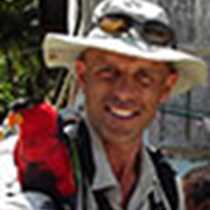Cabo de Hornos – Cape Horn
There were cheers in the lounge last night when Bud announced our plans for today. And we awoke this morning with a sense of excitement as the National Geographic Endeavour sailed past one of the most iconic locations in the maritime world – the island of Cabo de Hornos, perhaps better known as Cape Horn. As the most southerly point in the Americas, it was the point where all ships had to pass between the Atlantic and the Pacific before the opening of the Panama Canal.
After cruising and looking at the island from the sea as we rounded Cape Horn, our Captain once more positioned the ship perfectly and with a good sheltered anchorage we dropped the Zodiacs and made our way ashore. We landed on the boulder beach and made our way up the 150 steps to the plateau. Here we encountered the full force of the winds roaring in off the Southern Ocean; a full gale blowing in our faces. The Chilean flag, ripped to shreds by the wind and flying in tatters from the flagpole, provided ample evidence that our experience was not a one off.
The lighthouse and accommodation for the Chilean Naval Officer and his family (including their five-year-old son) were open for our visit. In addition, many walked out to the monument on the windswept headland overlooking the Drake Passage. This body of water and the rocky coast of Chile claimed the lives of many seamen in the days before the Panama Canal was opened, thus easing the transit between the Atlantic and the Pacific, and reducing the need to venture through the storm-tossed waters around Cape Horn. The monument is in remembrance of these lost souls and is a beautiful sculpture comprising two sheet of metal. From most angles it is difficult to see what the sculpture is but, when viewed just so, the gap between the two sheets makes the form of an albatross in flight. Combined with a moving poem inscribed on a nearby plaque, the monument is a fitting place to linger and think about those who passed through these waters before us, never to return to their families and friends. While for us, this is just what we will do tomorrow since we are now at the end of our extraordinary journey through the Chilean fjords.
There were cheers in the lounge last night when Bud announced our plans for today. And we awoke this morning with a sense of excitement as the National Geographic Endeavour sailed past one of the most iconic locations in the maritime world – the island of Cabo de Hornos, perhaps better known as Cape Horn. As the most southerly point in the Americas, it was the point where all ships had to pass between the Atlantic and the Pacific before the opening of the Panama Canal.
After cruising and looking at the island from the sea as we rounded Cape Horn, our Captain once more positioned the ship perfectly and with a good sheltered anchorage we dropped the Zodiacs and made our way ashore. We landed on the boulder beach and made our way up the 150 steps to the plateau. Here we encountered the full force of the winds roaring in off the Southern Ocean; a full gale blowing in our faces. The Chilean flag, ripped to shreds by the wind and flying in tatters from the flagpole, provided ample evidence that our experience was not a one off.
The lighthouse and accommodation for the Chilean Naval Officer and his family (including their five-year-old son) were open for our visit. In addition, many walked out to the monument on the windswept headland overlooking the Drake Passage. This body of water and the rocky coast of Chile claimed the lives of many seamen in the days before the Panama Canal was opened, thus easing the transit between the Atlantic and the Pacific, and reducing the need to venture through the storm-tossed waters around Cape Horn. The monument is in remembrance of these lost souls and is a beautiful sculpture comprising two sheet of metal. From most angles it is difficult to see what the sculpture is but, when viewed just so, the gap between the two sheets makes the form of an albatross in flight. Combined with a moving poem inscribed on a nearby plaque, the monument is a fitting place to linger and think about those who passed through these waters before us, never to return to their families and friends. While for us, this is just what we will do tomorrow since we are now at the end of our extraordinary journey through the Chilean fjords.




